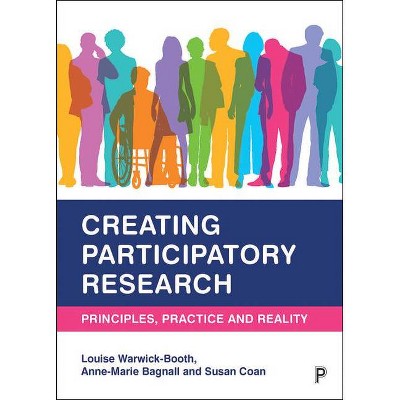Injury Research - by Guohua Li & Susan P Baker (Hardcover)

Similar Products
Products of same category from the store
AllProduct info
<p/><br></br><p><b> About the Book </b></p></br></br>This book focuses on contemporary injury research methods. It covers recent developments in theories, methods, concepts, and techniques in injury research and includes quantitative, qualitative, experimental and observational methods from multiple disciplines.<p/><br></br><p><b> Book Synopsis </b></p></br></br>Injury is recognized as a major public health issue worldwide. In most countries, injury is the leading cause of death and disability for children and young adults age 1 to 39 years. Each year in the United States, injury claims about 170,000 lives and results in over 30 million emergency room visits and 2.5 million hospitalizations. Injury is medically defined as organ/tissue damages inflicted upon oneself or by an external agent either accidentally or deliberately. Injury encompasses the undesirable consequences of a wide array of events, such as motor vehicle crashes, poisoning, burns, falls, and drowning, medical error, adverse effects of drugs, suicide and homicide. The past two decades have witnessed a remarkable growth in injury research, both in scope and in depth. To address the tremendous health burden of injury morbidity and mortality at the global level, the World Health Organization in 2000 created the Department of Injury and Violence Prevention, which has produced several influential reports on violence, traffic injury, and childhood injury. The biennial World Conference on Injury Control and Safety Promotion attracts a large international audience and has been successfully convened nine times in different countries. In the United States, the National Center for Injury Prevention and Control became an independent program of the federal Centers for Disease Prevention and Control in 1997. Since then, each state health department has created an office in charge of injury prevention activities and over a dozen universities have established injury control research centers. This volume will fill an important gap in the scientific literature by providing a comprehensive and up-to-date reference resource to researchers, practitioners, and students working on different aspects of the injury problem and in different practice settings and academic fields.<p/><br></br><p><b> From the Back Cover </b></p></br></br><p>Injury Research</p><p>Theories, Methods, and Approaches</p><p>Guohua Li and Susan Baker, editors</p><p> </p><p>From the long-held popular belief, "accidents will happen," it is now recognized that this needn't be the case. More and more, injury is being seen as no accident, not only predictable, but preventable--and an important public health issue requiring rigorous study and multiple levels of intervention.</p><p> </p><p>To this end, Injury Research: Theories, Methods, and Approaches assembles a team of multidisciplinary experts from around the globe. Early chapters provide a solid foundation for gathering injury data and monitoring trends. Research methods and injury-reduction approaches gleaned from public health, </p><p>medicine, engineering, behavioral science, and other areas demonstrate both the intricacies of causation and the potential for intervention. The result is an authoritative and comprehensive textbook relevant for anyone planning to enter a career in injury control and prevention.</p><p> </p><p>Featured in the coverage: </p><p> </p><p>- Methodological and technical issues in injury surveillance</p><p>- Concepts and methods for understanding causes of injury, from epidemiology to ergonomics to forensic pathology</p><p>- Methods and theories in measuring injury severity and for improving survival and functional outcomes, from patient triage to clinical prognosis to economic valuation</p><p>- Statistical methods and modeling techniques particularly well-suited for injury data analysis</p><p>- Multidisciplinary perspectives on injury control and program evaluation </p><p> </p><p> </p><p>Injury Research is a bedrock text for graduate students studying injury and violence epidemiology as part of a Master's in Public Health program. Graduate students in related fields including emergency medicine, biomechanical engineering, transportation safety, urban planning, risk assessment, and criminal justice will find this book an important reference as well.</p><p> </p><p>"The first textbook that comprehensively presents the theories and methods of injury research -- from the way ergonomics can reduce injuries to the effect of trauma-center systems on an injured person's chances of survival." - New York Times</p><p/><br></br><p><b> Review Quotes </b></p></br></br><br><p>From the book reviews: </p><p>"This is a multiauthored review of strategies for the investigation of injury and identification of treatment strategies. ... Clinicians and basic scientists seeking to understand patterns of injury and potential treatment strategies are an appropriate audience for this book ... . This is a worthwhile tool for committed investigators of this important public health problem." (David J. Dries, Doody's Book Reviews, February, 2015)</p><p>"Guohua Li ... have brought together a team of global experts from public health, medicine, engineering, and behavioral and social sciences to write about the latest advances in theories and methods for understanding the causes, mechanisms, and outcomes of injury as well as the strategies to prevent injuries. ... this is an essential reference book for anyone interested in violence prevention, emergency medical services, trauma care, risk assessment, crash investigation and litigation, and vehicle, occupational, recreational, and home safety." (Medical Xpress, January, 2012)<br><p/><br></br><p><b> About the Author </b></p></br></br><p>Dr. Guohua Li is the Finster Professor of Epidemiology at the Columbia University Mailman School of Public Health and College of Physicians & Surgeons. A medical epidemiologist, Dr. Li is interested in research methodology and injury-related, population-based and policy-oriented studies that encompass innovative epidemiologic designs, novel biostatistical techniques, and complex data systems. Dr. Li has published over 130 manuscripts in peer-reviewed journals and is well known for his studies of aviation crashes and the role of alcohol in injury causation and trauma outcomes. A Guggenheim Fellow and a Fellow of the American College of Epidemiology, Dr. Li is the recipient of the Kenneth Rothman Epidemiology Prize (1999) and the John Paul Stapp Award (2009). </p><p>Dr. Susan P. Baker is the Professor of Health Policy and Management and the founding director of the Center for Injury Research and Policy at the Johns Hopkins Bloomberg School of Public Health. She is widely recognized as one of the founders of the scientific discipline of injury epidemiology and prevention and is credited for developing the Injury Severity Score, a simple and effective tool for measuring the severity of multiple trauma that has been used worldwide by clinicians and researchers. She has authored over 300 publications, including the influential text Injury Fact Book, 1st and 2nd editions. Prof. Baker has received numerous awards, including the Charles A. Dana Award for Pioneering Achievements in Health and Higher Education and the Excellence in Research Award of the American Public Health Association.</p>
Price History
Price Archive shows prices from various stores, lets you see history and find the cheapest. There is no actual sale on the website. For all support, inquiry and suggestion messagescommunication@pricearchive.us




















